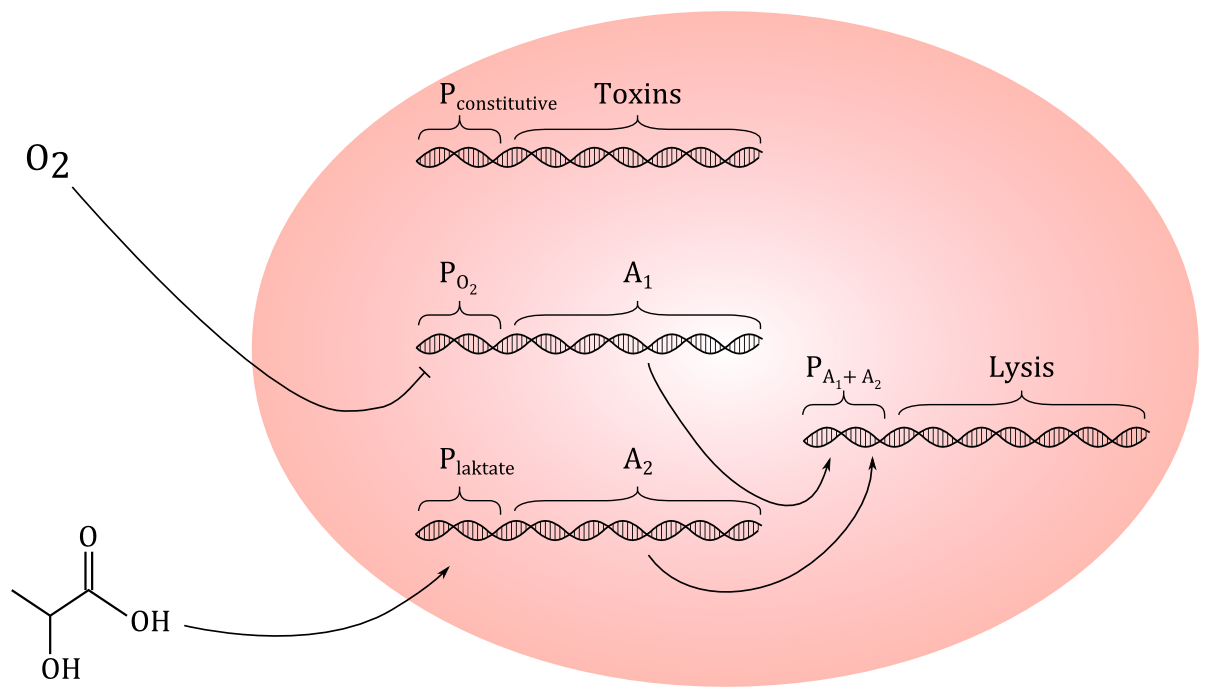Team:NTNU Trondheim/Project
From 2012.igem.org
(→Overall project) |
|||
| Line 39: | Line 39: | ||
== '''Overall project''' == | == '''Overall project''' == | ||
| - | + | Our goal for this years competition is to create a genetic circuit which enables ''E. coli'' cells to detect and attack cancer cells. To do this, the cells should produce a tumor inhibitor or toxin effective at killing cancer cells, and respond to environmental cues indicating the presence of cancer cells by undergoing [http://en.wikipedia.org/wiki/Lysis lysis], releasing the anti-cancer agent into the surrounding environment. In principle, bacteria could be used in "search and destroy" missions against cancer inside the human body. We wish to develop our genetic circuit as a proof-of-concept of one such strategy. | |
| - | Our goal for this years competition is to create a genetic circuit which enables ''E. coli'' cells to detect and attack cancer cells. To do this, the cells should produce a tumor inhibitor or toxin effective at killing cancer cells, and respond to environmental cues indicating the presence of cancer cells by undergoing lysis, releasing the anti-cancer agent into the surrounding environment. In principle, bacteria could be used in "search and destroy" missions against cancer inside the human body. We wish to develop our genetic circuit as a proof-of-concept of one such strategy. | + | |
A sketch of our current planned design for the circuit is shown below. | A sketch of our current planned design for the circuit is shown below. | ||
| - | |||
[[File:Genetisk_krets.png|center|750px|A sketch of our planned genetic circuit]] | [[File:Genetisk_krets.png|center|750px|A sketch of our planned genetic circuit]] | ||
| + | Ideally, the toxin should only be released if cancer cells are actually encountered, and never otherwise. To achieve this, the lysis-inducing part of the circuit should be regulated such that it is highly unlikely to activated in other situations. One possible way is to use a signal molecule that is solely associated with cancer cells to activate the lysis device. Another possibility is to use a combination of environmental cues that together indicate a high likelyhood of cancer presence. We have chosen the latter strategy, and the environmental cues we aim to use are low O2 and high lactate concentrations. | ||
| + | |||
| + | As shown in the sketch, we plan to express the toxin-producing gene with a constitutive promoter. This means that the toxin production alwayss be on. | ||
| + | |||
| + | Ideally, the toxin should be maximally effective against cancer cells and minimally toxic to the toxin-producing cell. We have evaluated several candidate molecules. At the moment, we are leaning towards using the molecule Colicin E1. | ||
== Project Details== | == Project Details== | ||
Revision as of 13:11, 22 June 2012
| Home | Team | Official Team Profile | Project | Parts Submitted to the Registry | Modeling | Notebook | Safety | Attributions |
|---|
Contents |
Overall project
Our goal for this years competition is to create a genetic circuit which enables E. coli cells to detect and attack cancer cells. To do this, the cells should produce a tumor inhibitor or toxin effective at killing cancer cells, and respond to environmental cues indicating the presence of cancer cells by undergoing lysis, releasing the anti-cancer agent into the surrounding environment. In principle, bacteria could be used in "search and destroy" missions against cancer inside the human body. We wish to develop our genetic circuit as a proof-of-concept of one such strategy.
A sketch of our current planned design for the circuit is shown below.
Ideally, the toxin should only be released if cancer cells are actually encountered, and never otherwise. To achieve this, the lysis-inducing part of the circuit should be regulated such that it is highly unlikely to activated in other situations. One possible way is to use a signal molecule that is solely associated with cancer cells to activate the lysis device. Another possibility is to use a combination of environmental cues that together indicate a high likelyhood of cancer presence. We have chosen the latter strategy, and the environmental cues we aim to use are low O2 and high lactate concentrations.
As shown in the sketch, we plan to express the toxin-producing gene with a constitutive promoter. This means that the toxin production alwayss be on.
Ideally, the toxin should be maximally effective against cancer cells and minimally toxic to the toxin-producing cell. We have evaluated several candidate molecules. At the moment, we are leaning towards using the molecule Colicin E1.
 "
"
